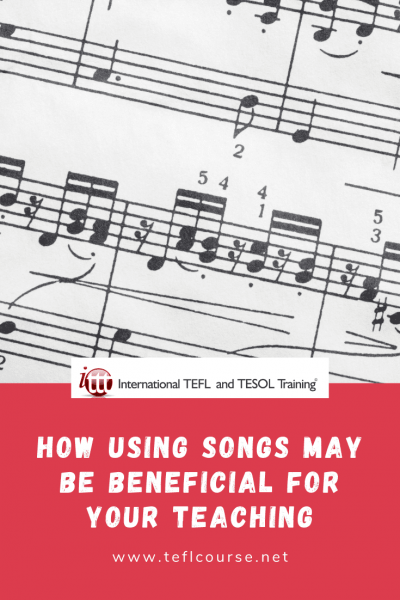How Using Songs May Be Beneficial for Your Teaching

Although all parts of a lesson are equally important, the "engage phase" may be the most important. The “engage phase” is the departing point of the lesson, and where you will focus the attention of the students away from the other occurrences of the day, and make them focus on learning the English language. Choosing the activity in which to grab the students' attention can be a challenge, as it must grab the students’ attention within one or two minutes. The best types of activities are those in which students are fully engaged in a cognitive, critical thinking process. Through various studies, music has shown to be an activity which utilizes many parts of the brain at once and therefore is a great activity to “jump-start” the brain, and get students to focus more quickly.
This post was written by our TEFL certification graduate Paul V. Please note that this blog post might not necessarily represent the beliefs or opinions of ITTT.
Advantages for the classroom environment
Music can benefit a classroom environment in many ways. First and foremost being that music, in general terms, is something that is enjoyed by more or less everyone. It can help students be calm and relaxed, while at the same time grabbing their focus. Generally speaking, most of the cognitive functions associated with music are the result of performance, however listening to music can still benefit the mind.

Also Read: Role of the Teacher: Jack of All Trades
Pros for the brain activity
A very similar activity that stimulates the brain, is learning a foreign language. Learning a language, combined with music, helps bring students to their fullest cognitive level within a very short amount of time, and as a result, has their brains “warmed up” for the remainder of a lesson. Various musical activities can be employed within the walls of the classroom, regardless of the age of the students. The easiest is to play a song, giving students the lyrics so that they can follow along. This can be a very effective comprehensive activity. Generally, most teachers will use more common, popular music that is appealing to a wider audience. Pop music, for example, would be an easier more relaxed exercise where the lyrics might be of a more simplistic nature, and not too long, perhaps 2-3 minutes. Additionally, within these songs there are repetitions, such as the chorus, that help students hear the same material more than once. Additionally, pop music very patterns like, often with a catchy melody which further helps students remember the material.
Ways to use songs
Other types of music may be employed for a more interesting and challenging activity. An example could be to use a more “Avante-Garde”, or obscure style of music, such as “Pierrot Lunaire” by Arnold Schoenberg, in which the music is sung in what most consider to be a bizarre manner. This creates an interesting challenge for the students, as they will have to more intensely focus on what the singer is trying to communicate. This method can be used for all ages and levels of students, however, the “Pierrot Lunaire” example is best employed with more advanced students.

Also Read: How much can I earn teaching English abroad?
A second activity would be to perform music as part of a group activity. As most students may be uncomfortable singing, it is best to hand our percussive style instruments, which merely require a pulse to play, or a very simplistic pitched instrument which could be taught and understood almost immediately. Alternately, a simple “clap along” can work as well. As this type of activity is rhythm-based, it can be used for helping learn the pronunciation of syllables, and also the rhythm and phrasing of a language. This method would be the most effective and ideal, as it can be used for all ages and levels of students. It is also, what I would call, a "full engagement” activity, meaning that it requires students to use multiple functions of their brain, thereby gaining and retaining their full attention.
Are you ready to teach English abroad? Take a TEFL course to get more career opportunities!
Learning a new language can be a very difficult and frustrating process. Adding some elements of joy or light, fun activities can really go a long way in helping students feel comfortable and relaxed. Music in a classroom proves a beneficial activity that not only helps relax students but also engages them to be able to learn in a more effective and focused manner. It is a fantastic warm-up activity to not only motivate students but also “jump-start” their brain so they can remain immersed for the duration of the lesson.
Apply now & get certified to teach english abroad!
Speak with an ITTT advisor today to put together your personal plan for teaching English abroad!
Send us an email or call us toll-free at 1-800-490-0531 to speak with an ITTT advisor today.
Related Articles:
- The Top 5 Places to Teach English in Japan | ITTT | TEFL Blog
- 10 Questions You Need to Ask Before Enrolling In a TEFL Course
- Step-By-Step Guide To Legally Teaching English in South Korea
- Online or In-Class - Which TEFL Course Should You Take?
- Teaching English Abroad: What's Next? - How To Advance In Your EFL Career
- Teaching English In China - The Salary and Budget Guide




